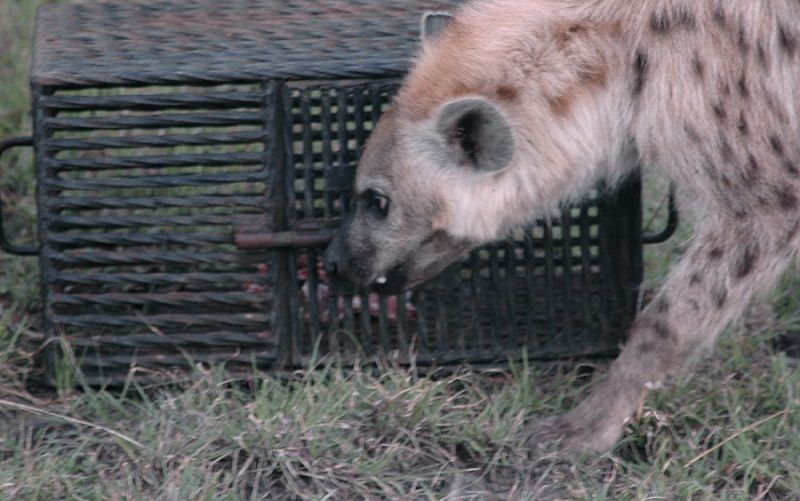Hyenas Have the Last Laugh

Confounding their usual cinematic portrayal as incessantly giggling numskulls, hyenas turn out to rank among the savvier characters on the African savanna. A new study finds that wild spotted hyenas employ a diverse range of tactics when attempting to open man-made "puzzle boxes." The carnivores can count, too — most of the pads on one paw, at least.
Impressive mental gymnastics have been observed among all kinds of animals in recent years, demonstrating time and again just how mistaken humans once were about animal cognition.
"It is particularly fun to discover such abilities in hyenas, a species that is subjected to so many negative stereotypes," said hyena zoologist Sarah Benson-Amram, a research fellow at the University of St. Andrews in Scotland.
Over the past few years, Benson-Amram and her colleagues have conducted a series of experiments with a clan of wild spotted hyenas in Kenya. Unlike other hyenas (which live roguish lifestyles), the estimated 27,000 to 47,000 members of the spotted species, Crocuta crocuta, live in groups similar in size and structure to troops of baboons. Within their hierarchical, 90-member clans, they lead complex social lives, networking and competing, cooperating to solve problems, recognizing the rank relationships of others, reconciling after fights and forming coalitions. [Hyena's Laugh Actually Fighting Words]
And all that takes brainpower. In their latest study, published last month in the journal Proceedings of the Royal Society B, the researchers found that spotted hyenas use trial-and-error when attempting to open puzzle boxes full of meat, trying out such behaviors as biting, pulling and flipping the boxes. Only about 15 percent of the hyenas in the study ultimately managed to open the boxes, but the researchers said the behavioral flexibility they displayed when confronted with the foreign objects was akin to human creativity.
In a study published in 2011 in the journal Animal Behavior, Benson-Amram and colleagues observed the hyenas' reactions to distant recordings of vocalizations by one, two or three unknown male hyenas. The real-life hyenas judged whether or not to approach or retreat from the presumed intruders in the recording depending on whether they outnumbered the males they could hear. In other words, they could count to three. [When Will We Learn to Speak Animal Languages?]
Okay, hyenas won't land robots on Mars anytime soon. Some media coverage of the new studies claims wild spotted hyenas could go head-to-head with primates. Not so.
Sign up for the Live Science daily newsletter now
Get the world’s most fascinating discoveries delivered straight to your inbox.
"There can certainly be no question that the general behavioral flexibility of hyenas is far less than that found in most primates, and many of us consider behavioral flexibility to be a hallmark of intelligence," said study co-author Kay Holekamp, professor of zoology at Michigan State.
And yet, they do outperform humans' closest living relatives — chimpanzees — on tasks requiring cooperation. In an experiment published in 2009 led by Christine Drea, an evolutionary anthropologist at Duke University, captive pairs of spotted hyenas were challenged to tug two ropes in unison to earn a food reward. The pairs cooperated successfully, learning the maneuvers quickly with no training. Experienced hyenas even helped inexperienced partners do the trick. Drea said chimps often require extensive training to do similar tasks.
Clearly, hyenas have more going on upstairs than humans once thought.
According to Benson-Amram, there are two major theories regarding the evolution of intelligence. "One states that intelligence evolved to deal with social challenges. For example, individuals need to be able to recognize and respond appropriately to different group members. The other theory states that intelligence evolved to deal with ecological challenges in the environment. For example, individuals need to navigate around their habitat, find food, and potentially extract or prepare food, in order to survive and produce offspring," she told Life's Little Mysteries.
Whichever theory of intelligence one prefers, spotted hyenas pass muster. "They live in both social and ecologically challenging environments," Benson-Amram said. As well as adeptly navigating the social sphere, "they hunt everything from termites to giraffes," she said. "They hunt alone and in groups. They take down zebras that could kill them with a strong kick, and they compete with lions for resources. Spotted hyenas are the most abundant large carnivore in sub-Saharan Africa, which shows how well they can adapt to deal with life in varied environments."
They can also innovate when confronted with new situations, she said. As other carnivores struggle to adapt in this rapidly changing world, hyenas appear to be having the last laugh.
Follow Natalie Wolchover on Twitter @nattyover or Life's Little Mysteries @llmysteries. We're also on Facebook & Google+.
Natalie Wolchover was a staff writer for Live Science from 2010 to 2012 and is currently a senior physics writer and editor for Quanta Magazine. She holds a bachelor's degree in physics from Tufts University and has studied physics at the University of California, Berkeley. Along with the staff of Quanta, Wolchover won the 2022 Pulitzer Prize for explanatory writing for her work on the building of the James Webb Space Telescope. Her work has also appeared in the The Best American Science and Nature Writing and The Best Writing on Mathematics, Nature, The New Yorker and Popular Science. She was the 2016 winner of the Evert Clark/Seth Payne Award, an annual prize for young science journalists, as well as the winner of the 2017 Science Communication Award for the American Institute of Physics.












